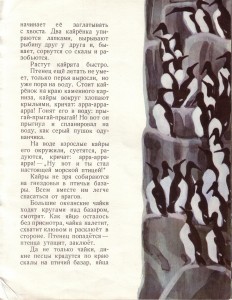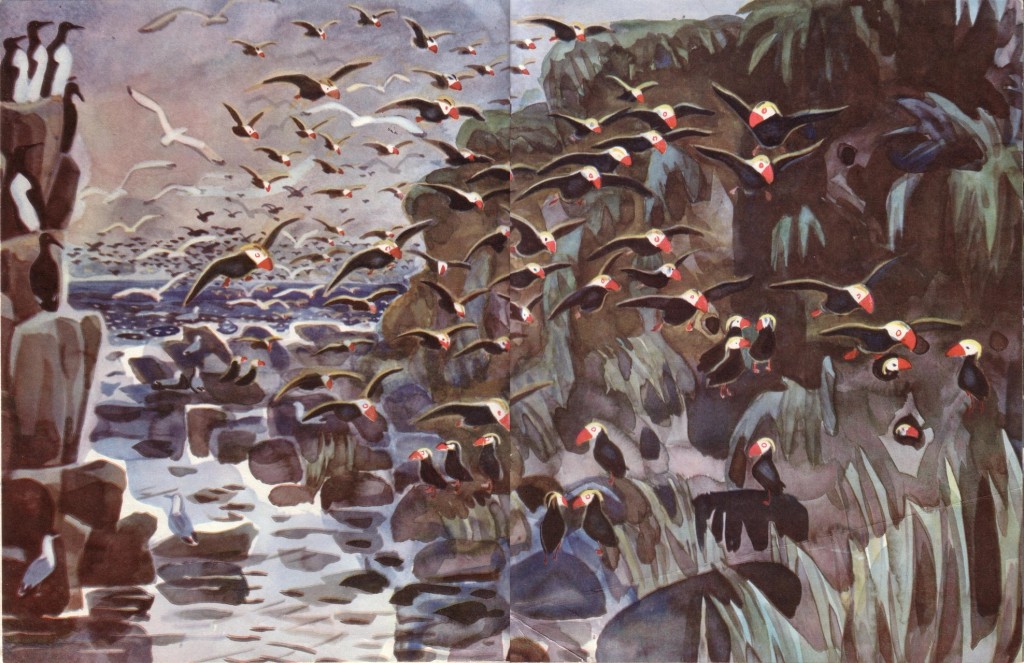На Командорах / On the Commander Islands – Sea Birds
 Quick and dirty translation, part 2. See also, part 1, Fur Seals.
Quick and dirty translation, part 2. See also, part 1, Fur Seals.
На Командорах [Na Komandorakh] On the Commander Islands. Author: Gennady Snegirev. Artist: M. Miturich. Izdatel’stvo “Malish”. Publisher “Little One”. For older preschoolers. A print run of 350,000 in 1975. Cost, 16 kopecks.
Full Russian book scanned here.
In spring endless caravans of murres [кайра] fly to the hanging cliffs.
On each ledge of the cliff, in each crack, on every stone, wherever they can get a spot, sit the murres. They sit so tightly packed that they can barely move. Guillemots fly in and sit on the heads of others. All the murres screech: arra-arra-arra, but then they calm down again.
And so it is possible when a ship goes by in the fog, to hear the screeching a kilometer away — you know that on the cliff are nesting hundreds of thousands of murres.
This is a rookery. [птичий базар [ptichii bazar] – lit. bird bazar]
p. 3
Murres are sea birds. They have thick feathers, and under the feathers a real “fur coat” of down, warm and light, so that guillemots aren’t afraid of cold winds or the icy sea. Under the water murres can fly, “rowing” their wings like our, and if they need to turn, they use a foot instead of a rudder. And so they fish underwater, and not a single fish gets away from them, not even the fast herring. However, when the murre flies in the air, it is pretty funny to look at — flapping its little wings with all its might, like little hands.
During the summer, a murre will lay just one egg, and both parents will take turns sitting on it: one murre can fly to the sea to feed, the other warms the egg.
And each pair returns each year to the same rookery, the same cliff, and even puts their egg on the same rocky ledge as the previous year.
If the spring is not mild, the murre do not wait until the snow melts. They put the egg on top of their feet and it is heated from above by the warm down.
The egg is big, twice the size of a chickens, and looks like a pear or a Van’ka-stan’ka. On the wide end, the shell is thin, while the pointed end is thicker and heavier, therefore the murre eggs almost never fall off, even from the small cliff spaces. The eggs are bluish or greenish, like an ocean wave, and covered with black splotches and brown stains, as if someone dipped a brush in paint and tried to draw on them.
After a month gray chicks hatch. They are covered with thick down so that they wind doesn’t chill them on the bare cliffs. At first the mother doesn’t leave the chick and her body protects it from the cold wind.
The baby murres are very gluttonous. The parents feed the chicks fish. Sometimes they bring the chick a such a big herring that the chick can only swallow half of it and the tail sticks out, but the chick will still not spit out the herring. Another chick will try to take the fish, starting to eat the tail. Two chicks toe to toe, pulling the fish between each other, and it happens that they can fall from the cliffs and be smashed.
The little murres grow quickly.
The chicks still cannot fly until their feathers grow in, but it’s already time for the water. The young murre stands on the edge of the rocky ledge, the murres around flap their wings and screech: arra-arra-arra! They urge him into the water: jump-jump-jump! And then he jumped and glided down to the water, like the grey fluff of a dandelion.
In the water the adult murres suround him, fussing over him, celebrating and crying: arra-arra-arra! — Well, now you have become a real sea bird!
It’s not for nothing that the murres gather together to nest in the rookery. When everyone’s all together it’s easier to save themselves from predators.
Big sea gulls go around the rookery, looking. If an egg is left unattended, a gulls lands, takes the egg in its beak and pecks it open. If a chick gets lost, a gull will carry it away and peck it to death.

Full double page illustration spread.
And not only gulls, wild Arctic foxes slink around the edge of the cliffs of the rookery to steal eggs. The Arctic fox takes the egg in its jaws and carries it away to its den, then comes back for a second, carries off more eggs and then gnaws a hole in the shell and drinks [the egg]. Near Arctic fox burrows are found whole piles of shells. The Arctic fox sneaks along narrow ledges stealing eggs, and sometimes falls down below and is smashed to death. All the same, the tastiest meal for them — murre eggs. They really are tasty. People gather hundreds of thousands, make from them egg powder or fry omelets. When they bake cookies, they add [murre eggs] to the dough, so it will be rich. And children in the Far East really love murre eggs: they eat them in schools, and in kindergartens.
They gather murre eggs only once, so the murres have a second chance to have an egg and feed a chick during the summer.
Not only murres get together for a common nesting — bird rookery. There’s a colony of puffins. They don’t keep their eggs on rocks, but dig deep burrows — caves lined with moss and grass in which they raise their chicks. The puffins’ island is all pitted with puffin burrows. Puffins are also called “sea parrots.”
A puffin is a dark brown bird, on its head two tufts of golden feathers. They are called “топорок” [toporok] because their beak looks like a “tопорик” [toporik – hatchet] and all in red, orange and green stripes. With its strong beak the puffin digs its burrow.
Third and final installment next week: Arctic foxes, people.